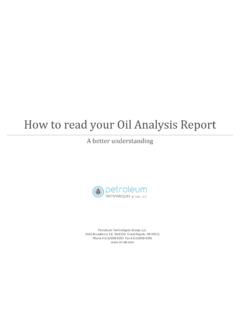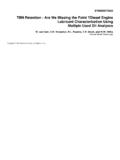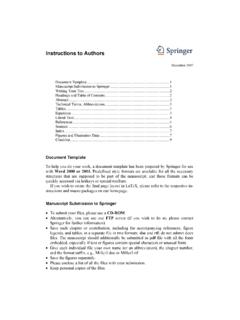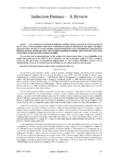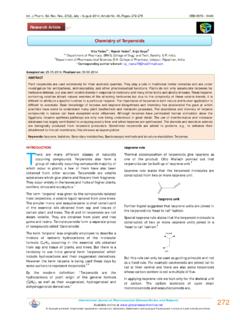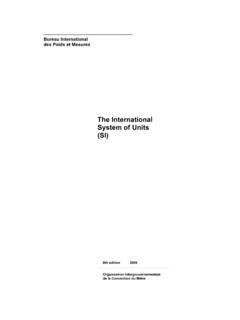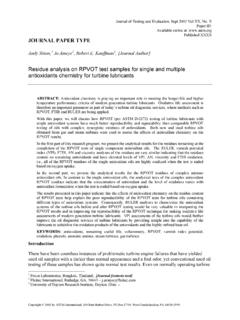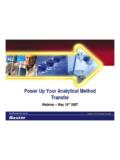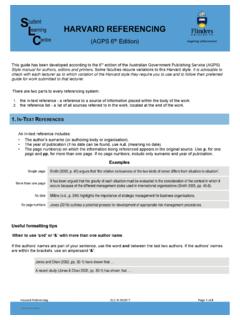Transcription of Petro tech brochure rev 3-1
1 Petroleum Technologies Group, LLC Testing solutions for the future 4665 Broadmoor Ave. Suite 150 Grand Rapids, MI 49512 PO Box 8725 Grand Rapids, MI 49518 p / f petroleum technologies 4 TrendOil Analysisp. 4 Engine, Transmission&Hydrauli c Systemsp. 5 Oil AnalysisMeasurep. 5 Why Oil Analysis? (IR) IR? ApplytoLube Analysis ? Applic atio n Summaryp. PetroleumTechnologiesAnalysis? 18 Interpretatio n ofResultsp. 18 INDUSTRIAL OIL AND GEAR BOXES Wear - INTERNATIONAL STANDARDS - RECOMMENDED CLEANLINESS CODE 19 INDUSTRIAL RECOMMENDED CLEANLINESS CODE CHART Valves Pressure 2000 3000+ Directional (Solenoid) 18/15 17/14 Press Control 17/14 17/14 Flow Control 17/14 17/14 Check Valves 18/15 18/15 Cartridge Valves 16/13 15/12 Proportional Directional/Flow/Pressure 15/12 14/11 Servo Valves 14/11 13/10 BASICS OF OIL ANALYSIS INTRODUCTION For many years, lubricant inspection and testing has been used to help diagnose the internal condition of oil wetted components and to provide valuable information about the lubricant serviceability.
2 The first test methods used for this purpose included such simple procedures as smelling used oil for the sour odor of excess acid, checking visually for obvious signs of contamination or placing a small drop of sample on absorbent paper to detect contaminates and monitor additive effectiveness. Modern day analysis is built on these early efforts. The importance of using a combination of physical and spectrochemical tests to monitor lubricant and component conditions is not universally accepted. Oil analysis test procedures are established and reviewed by such agencies as the International Standards Organization, the American Society of Testing Materials and the Society of Automotive Engineers. Today, little doubt remains that a comprehensive oil analysis program is a very valuable tool.
3 TREND OIL ANALYSIS All oil analysis programs are designed to be performed as a trend analysis. This is a regularly scheduled set of samples over a span of time. A trend is a unique history of what is happening to a unit within its specific application. To establish a trend, at least three samples ar e needed. All the test data on a sample is relevant to: Hours or mileage on the oil With time, the oil is accumulating more and more detectable metals What would be normal readings for an engine with 10,000 miles on an oil drain would be high readings on an engine with 1,000 miles on an oil drain Time on the engine itself Each system has a life span and there will be differences in results along the way One oil sample, taken after a failure, does not show the history of how the failure developed or how long it existed.
4 Only a trend can do this. With failure analysis it is very difficult to reconstruct what caused the problem. The test data for an oil sample will sometimes fail to support the problem or failure when the service is used as a one sample failure analysis. With waiting until there is an indication of a problem to use oil analysis the true value and purpose has been lost. Establishing a trend will give an early alert so that corrective action can be taken to prevent a major failure. PETROLEUM TECHNOLOGIES OIL ANALYSIS PROGRAM OIL ANALYSIS PROGRAM FOR ENGINES, TRANSMISSIONS AND HYDRAULIC SYSTEMS A superior program of oil analysis is a vital part of today s good maintenance. Analysis programs detect internal engine parts that are wearing at abnormal rates, whether oil additive packages are breaking down and finally they measure the physical condition of the oil and the levels of contamination.
5 Oil Analysis programs are vital to a strong preventative maintenance program. WHAT DOES OIL ANALYSIS MEASURE? Petro tech oil analysis tests a sample of oil taken from your equipment right after shut down. Three different types of testing are done on the sample: Physical and chemical testing, which measures problems such as the percentage of water or fuel dilution; the presence of coolant, carbon build up or silica dirt; and a measure of viscosity ICP analysis, which measures the presence of even the most microscopic particles of metals, can determine whether engine component wear rates are taking place at an abnormal rate Infra Red testing is performed on the sample to determine the condition of the oil additive package. This test can help to determine if the oil drain intervals are at the proper length for the equipment and conditions of usage WHY USE OIL ANALYSIS?
6 Oil analysis makes it possible to literally look inside an engine, transmission or hydraulic system. By monitoring the oil, its condition and the presence of contaminates, an oil analysis user can anticipate problems, monitor system wear and repair problems before they become catastrophic. Some of the specific uses of oil analysis include: Noting progressive wear in order to repair damaged parts before they become emergency break downs Detection of corrosive acids, coolant, fuel dilution and other oil conditions which are caused by engine problems that could become major failures Planning of needed repairs based upon the noted progression of an abnormal wear pattern, which can lead to more effective equipment utilization and fewer emergency repairs Oil Analysis provides useful records when handling warranty problems, resale of equipment, detection of abuse and evaluation of new oils.
7 Oil filters and air filters 18 INDUSTRIAL RECOMMENDED CLEANLINESS CODE CHART Actuators Bearings Pumps Pressure <2000 2000 3000 3000+ Ball Bearing System 13/11 Roller Bearing System 14/12 Journal Bearings (High Speed) 15/13 Journal Bearings (Low Speed) 16/14 General Industrial Gear Boxes 15/13 Pressure <2000 2000 3000 3000+ Cylinders 18/15 18/15 18/15 Vane Motors 18/15 17/14 16/13 Axial Piston 17/14 16/13 15/12 Gear Motors 19/17 18/15 17/14 Radial Piston 18/14 17/13 16/13 Cam Wave Motor 16/14 15/13 14/12 Pressure <2000 2000 3000 3000+ Fixed Gear 18/15 17/15 Fixed Vane 18/15 17/14 16/13 Fixed Piston 17/15 16/14 15/13 Variable Vane 16/14 15/13 Variable Piston 16/14 15/13 14/12 17 ISO INTERNATIONAL STANDARDS ORGANIZATION Typical Hydraulic Components Requirements Suggested Contamination Levels for Various Hydraulic Systems ISO 14/11 Servo Control Valves ISO 16/13 Vane and Piston Pumps ISO 16/13 Directional and Pressure Control Valves ISO 17/14 Gear Pumps ISO 18/15
8 Flow Control Valves and Cylinders Target Class Sensitivity System 13/9 Super Critical Silt sensitive control system. Laboratory or Aerospace. 15/11 Critical High performance servo and high pressure systems. 16/13 Very Important High quality systems. General machine requirements. 18/14 Important General machinery and mobile systems. Medium 19/15 Average Low pressure industrial systems 21/17 Main Protection Low pressure with large clearances. INFRARED ANALYSIS Infrared analysis has been employed as an analytical technique for many years, with respect to monitor ing used lubes, its application was highly limited by: A need for a reference sample (usually a new sample of lube being analyzed) Opacity of the sample lack of sufficiently sophisticated instrumentation corresponding costs to obtain trustworthy data The above objections could be partially overcome.
9 The analyzing facility limited its scope to only a few products or base materials, such as an individual lube formulator analyzing only his/her own products. The technology today, however, is now available to transcend the limitations above and is offered as a routine service. WHAT IS INFRARED? IR is one of numerous spectrometric techniques for analyzing the chemistry of materials. In all cases spectrometric analysis implies a measurement of a very specific wavelength of light energy, either in terms of amount absorbed by the sample the question or the amount emitted from the sample when suitably energized. IR is an absorption form of spectrometric analysis. Unlike atomic absorption, IR is not concerned with specific elements (lead, copper, etc.)
10 But rather with the grouping of atoms in specific combinations to form what are called functional groups . These various functional groups help to determine a materials properties or expected behavior. By knowing which wavelengths are absorbed by each functional group of interest, one can cause the appropriate wavelength to be directed at the sample being analyzed and measure the amount of energy absorbed by the sample. The more energy absorbed, the more of that particular functional exists in the sample. Results can therefore be numerically quantified. The units of measurement are usually expressed as Absorbance Units . HOW DOES IR APPLY TO LUBE ANALYSIS? It is useful for the layman to treat infrared analysis as the chemistry of Carbon, Hydrogen, Oxygen, Nitrogen and Sulfur and the various combinations in which these elements configure or attach themselves.
